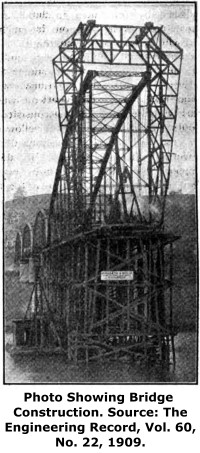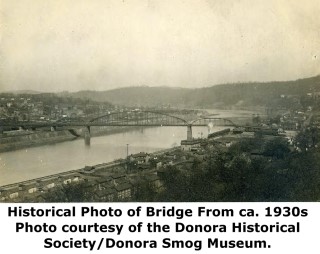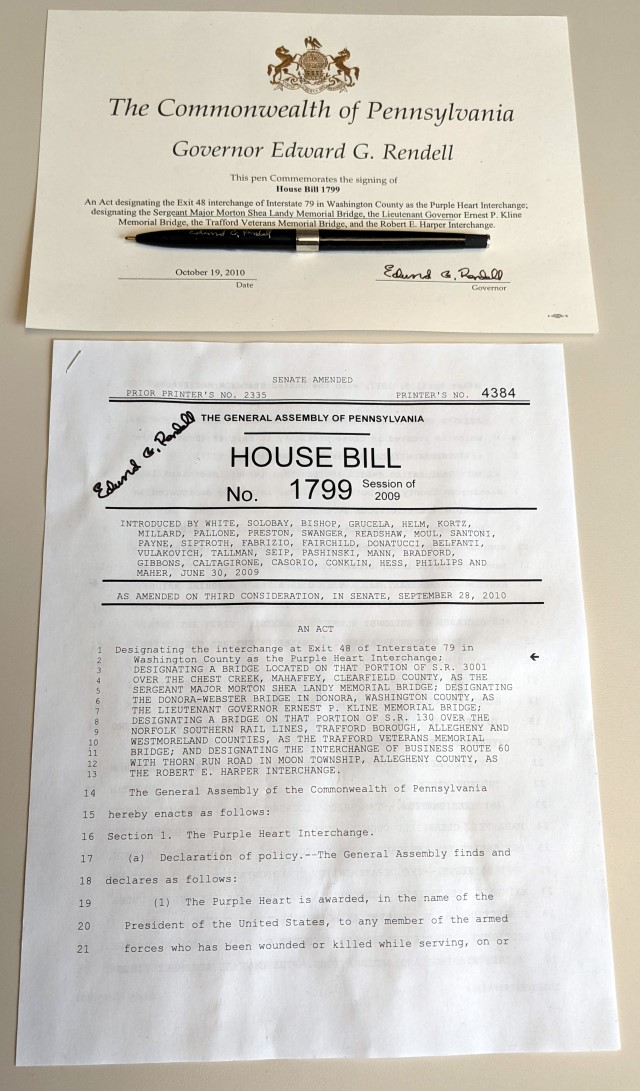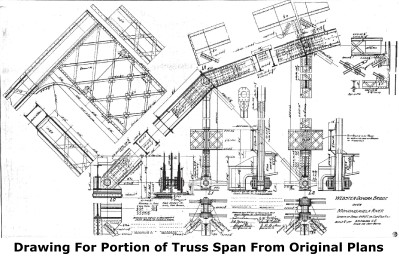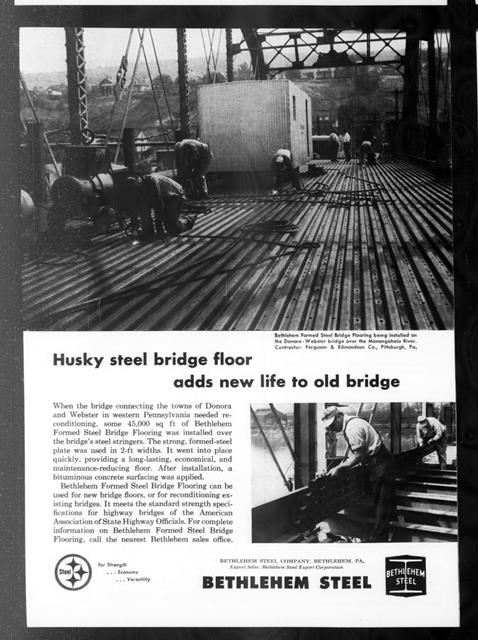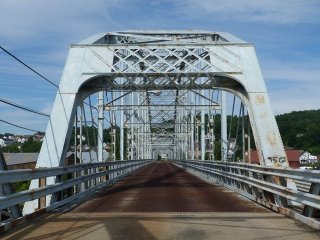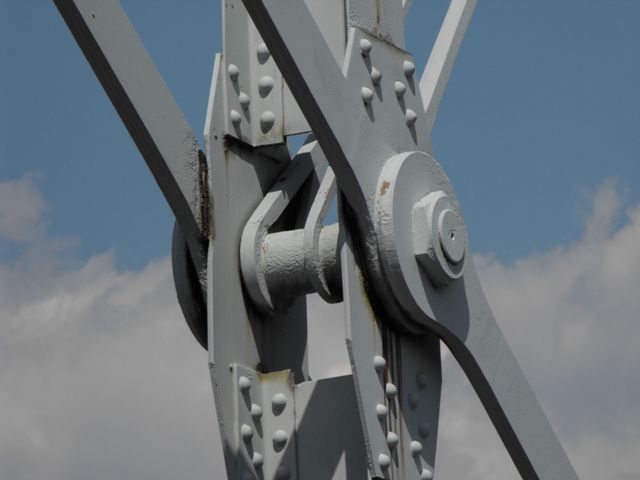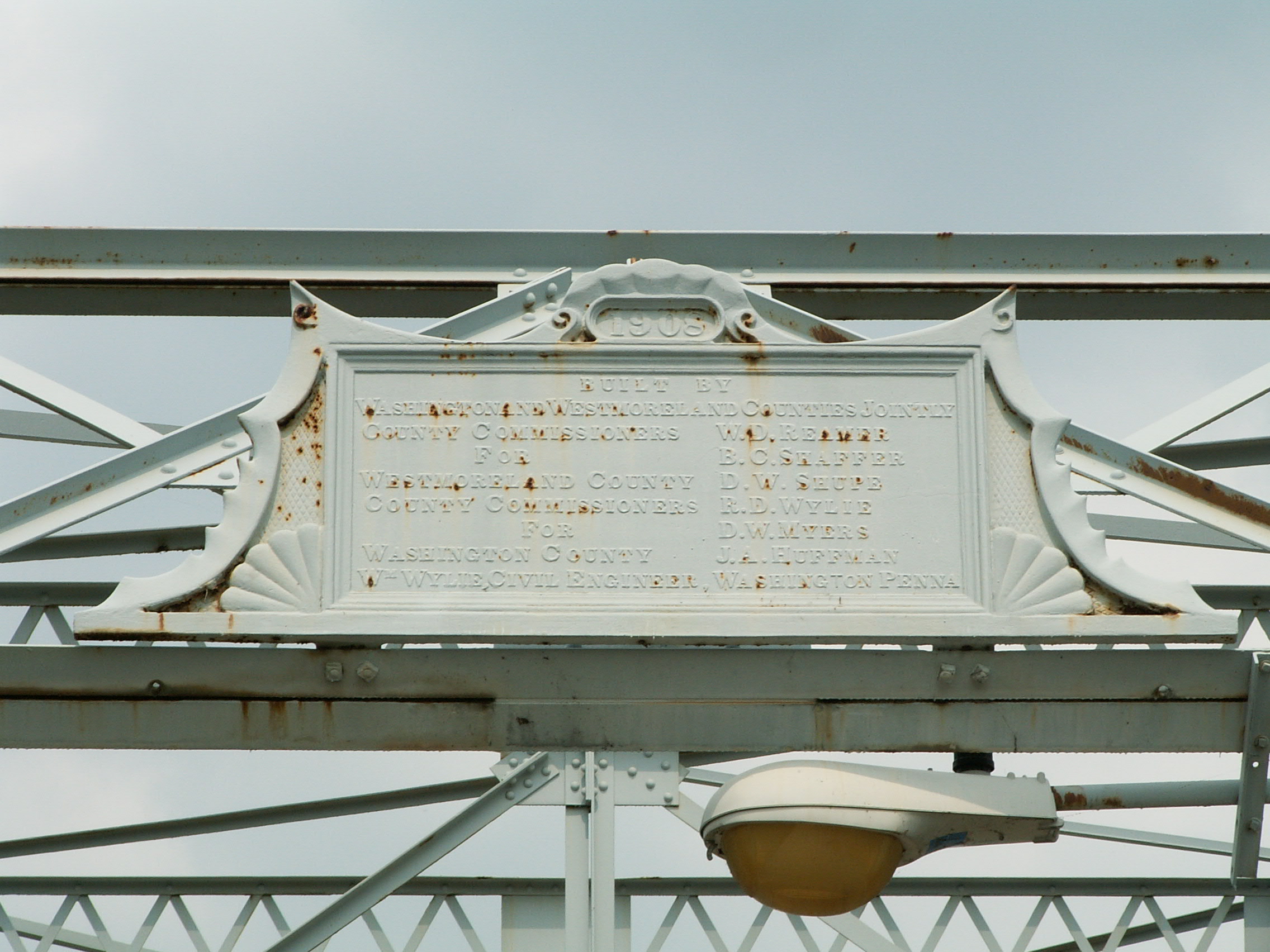We Recommend:
Bach Steel - Experts at historic truss bridge restoration.
BridgeHunter.com Phase 1 is released to the public! - Visit Now
Donora-Webster Bridge
Lieutenant Governor Ernest Kline Bridge
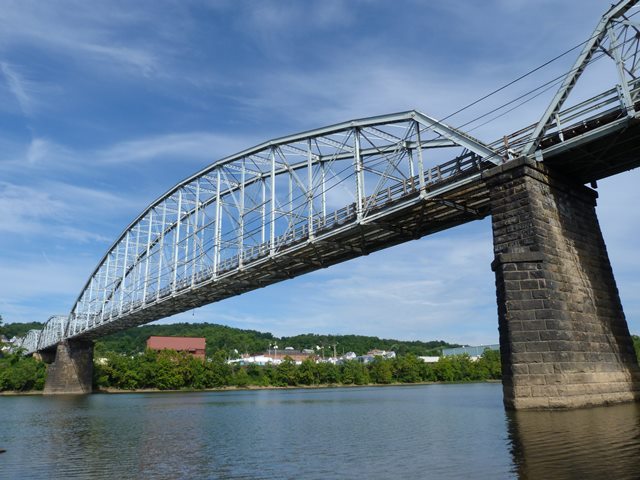
Primary Photographer(s): Nathan Holth
Bridge Documented: July 3, 2006, August 20, 2010, June 30, 2014, and July 6, 2014
Donora and Webster: Washington County, Pennsylvania and Westmoreland County, Pennsylvania: United States
Metal 20 Panel Pin-Connected Pennsylvania Through Truss, Fixed and Approach Spans: Metal 9 Panel Pin-Connected Parker Through Truss, Fixed
1908 By Builder/Contractor: Toledo-Massillon Bridge Company of Toledo, Ohio and Engineer/Design: A. N. Nelson
1986
518.0 Feet (157.9 Meters)
1,547.0 Feet (471.5 Meters)
22.6 Feet (6.89 Meters)
5 Main Span(s) and 9 Approach Span(s)
62102200100036

View Information About HSR Ratings
Bridge Documentation
This bridge no longer exists!
This bridge's song is:
View Archived National Bridge Inventory Report - Has Additional Details and Evaluation
This historic bridge was demolished with no reasonable purpose by PennDOT July 1, 2015, 10:00 AM EDT.
View A Historical Article Discussing The Construction of this Bridge
View Original Plan Sheets For this Bridge
About This Bridge
This spectacular historic bridge sits on stone piers and has pinned connections. The largest main span is a Pennsylvania truss configuration, while the others are Parker truss spans. The main Pennsylvania span is 515 feet which is among the longest simple span truss lengths in Pennsylvania. The bridge is listed on the National Register of Historic Places and is historically and technologically significant for its span length, rare Pennsylvania truss configuration, use of pinned connections, as well as its large, multi-span configuration. Given the age of the bridge and use for many years of its history functioning as an important and busy crossing for the area, the number of alterations on the bridge are small and the bridge should be considered to have excellent historic integrity.
The main (channel) span of the bridge was described as one of the longest and heaviest highway truss spans in the country when completed. It weighed 1,400,000 pounds when completed, composed of trusses that were 70 feet deep (tall). The bridge cost $189,500 to build. Like most simple span trusses, it was erected upon timber falsework. However because the river was navigable, the channel span had to be erected in halves. Once the first half was completed, most of the falsework under that half could be removed, allowing boats to pass under, making it possible to erect the falsework for the other half of the bridge. During this time, the first half of the bridge acted like a single span, and a portion of the falsework at the end of this half acted like a temporary pier. Typical of large bridges built during this period, the bridge was erected with the assistance of a giant traveler. The traveler can be seen in historical photos showing the construction of the bridge. The bridge was built to plans developed by the joint boards of Washington and Westmoreland Counties, under direction of W. E. Wylie and John Grundy. The actual bridge plans also list A. N. Nelson as engineer for the Joint Board. Little is known about any of these engineers. The Toledo-Massillon Bridge Company fabricated the steel superstructure, and was erected by on-site contractor Dunseath Engineering Company of New York, New York, which was run by Robert Dunseath. The entire bridge was erected with no deaths and only one minor finger injury. Only one minor structural incident occurred when a hand railing brace fell into the river. This lack of incidents was reportedly unprecedented among the construction of bridges on the Ohio, Monongahela and Allegheny Rivers at that time.
Beyond historic and technological significance, the bridge is an extremely beautiful bridge that is a unique and distinguishing landmark for the communities of Donora and Webster which it serves. The pin connections and riveted, built-up beams on the bridge which contain attractive v-lacing and lattice are not only historically significant of historical methods of construction no longer used today, they also contribute strongly to the aesthetic value of the bridge and the interpretation of the bridge as a beautifully complex geometric art form.
Few states in the country can claim to have a pin-connected highway truss bridge of this size. A bridge like this should be one of Pennsylvania's most treasured landmarks. Sadly, it is instead slated for demolition.
When PennDOT conducted the historic bridge inventory, this bridge was considered to be the third largest Pennsylvania truss span in the state. Also, it is worth noting, that among the seven largest Pennsylvania truss spans in the Commonwealth, five of them, including the Donora-Webster Bridge, are slated for demolition and replacement, or have already been demolished since the significance of the Donora-Webster Bridge was considered by PennDOT. The bridge currently being replaced and soon to be demolished bridge is the Hulton Bridge. The now-demolished bridges include the Masontown Bridge, Charleroi-Monessen Bridge and the Tunnelton Bridge. The loss of these bridges is devastating for Pennsylvania's heritage, however their demolition also drastically increases the rarity and significance of the Donora-Webster Bridge.

Demolition: A Ridiculous Waste of Money and History
Shortly after this bridge was demolished, PennDOT spokesperson Valerie Petersen was quoted by the Observer Reporter as saying "It's a new beginning." The beginning of what? The beginning of two communities forever severed in two, never again to be united? The beginning of Pennsylvania without any Pennsylvania truss bridges? The beginning of Pennsylvania devoid of beautiful historic bridges? The demolition of this bridge was the beginning of nothing!
Pennsylvania is notorious for taking some of the most obvious opportunities for preservation and throwing them away, even for the most significant of historic bridges. For example, historic bridges that are not in the way of a replacement bridge are often demolished even though they could be left standing either as abandoned monuments or as pedestrian bridges. The fate of the Donora-Webster Bridge is similarly ridiculous. This bridge is being demolished for no reason other than to reduce one of Pennsylvania's finest historic bridges to a pile of scrap metal. The bridge is not in the way of anything. No new bridge is to be built at this location. It is just being demolished. $2,601,566.39. That is how much it will cost to destroy one of the most beautiful and historic bridges in the country. Imagine if you have millions of dollars burning a hole in your pocket. Sure, you could hire a firm like Bach Steel that has experience restoring metal truss bridges and can stretch every dollar to its furthest to restore a bridge like this for pedestrian use for minimal cost. But why use that money to preserve a historic bridge, and create a useful pedestrian link when you can instead use that money to destroy a priceless piece of Pennsylvania's steel and transportation heritage? Apparently that was the thinking with this bridge. In reality... that a bridge of this size, age, and rarity would even be considered for demolition in 2014 is nothing short of barbaric. To actually spend millions of taxpayer dollars to execute such an act of unwarranted destruction is irresponsible and disgusting.
It is clear that this bridge, which was determined to be unimportant for continued vehicular use, would have been an outstanding candidate for preservation for pedestrian use. The bridge did have some areas of substantial deterioration, but overall most of the bridge was in decent shape. Selected repairs to the areas of the worst deterioration would have been an inexpensive way to make the bridge sturdy enough that it could stand on its own and bear the light loads of pedestrians. However the shortsighted lack of vision that has plagued Pennsylvania with so many historic bridges descended upon this bridge and these possibilities for useful spending of tax dollars and preservation of a beautiful bridge with substantial heritage value were swiftly sent the same place that this bridge has been condemned to: the dumpster.
All that will remain of this bridge at the site after demolition will be a sign as detailed here.
Those who followed the project planning process that led to the demolition and replacement of the Charleroi-Monessen Bridge will remember another issue with this bridge. PennDOT for a time claimed that they although they were demolishing that bridge, they would in return preserve the historic Donora-Webster Bridge. This seemed like a decent compromise. However as soon as the dynamite blew the Charleroi-Monessen Bridge to bits, the commitment to preserve the Donora-Webster Bridge was also blown to bits.
There were other issues that suggested that the best interest of the people may have not been part of the decision to destroy this historic bridge. This was detailed in a February 16, 2012 article in the Pittsburgh Tribune-Review. Apparently, PennDOT kept its plan to demolish the bridge secret until they suddenly unveiled it at a public meeting as a declaration that was no open to any sort of discussion or input from the public. Even local lawmakers were taken by surprise. State Representative Peter Daley said "I thought they were being secretive" of PennDOT. Additionally, Daley said "I thought it was something the public should have known from the very beginning. I think they wanted to keep the crowd down." The input of the local residents was not considered. Not only was this historic bridge an iconic landmark for a community, it was an important functional crossing. Its loss could add up to eight miles of travel for many area residents.
Renaming of the Bridge in the Shadow of Demolition
Another irony is that the bridge was renamed the Lieutenant Governor Ernest Kline Bridge in 2010 (after the bridge was closed in 2009). What sort of message does that send to anyone who appreciated Ernest Kline? They rename a bridge after someone just before they are about to blow the bridge up? That doesn't seem like it honors the person its named after! However, there is a little more to this story. HistoricBridges.org is thankful for the following information provided by Robert Kline in response to this:
The message is one of great admiration for Ernie's lifetime commitment to public service and his playful sense of humor. Ernie Kline was my uncle. I grew up in the same house where he lived as a child, just a short walk from that bridge. As soon as I learned the bridge was slated for demolition, I drafted an amendment to name the bridge after Uncle Ernie. The amendment received fast approval as a testament to Ernie's reputation in the Pennsylvania State Capitol in Harrisburg, Pennsylvania, where I have been fortunate to work since 1988. Below is a photo of the commemorative pen used by Governor Rendell to sign the bill as well as a copy of the bill itself, also signed by the Governor. My family and I drove back home on demolition day and watched as the bridge disappeared into a cloud of smoke. It was a day of mixed emotions ranging from sadness that an essential crossing point over the Monongahela River was lost to time; and, happiness that somewhere in heaven Uncle Ernie was flashing his infectious smile along with a sly grin at the thought that politicians shouldn't always take themselves so seriously.

A Legacy of Destruction On Two Great Rivers
Noteworthy Historic Bridges Demolished (Or Soon To Be) On The Allegheny River (2004-2016)
 |
 |
 |
 |
 |
 |
| Hunter Station Bridge | Hulton Bridge | West Hickory Bridge | Foxburg Bridge | East Brady Bridge | Pennsylvania Turnpike Bridge |
| Status: Slated For Demolition | Status: Demolished | Status: Demolished | Status: Demolished | Status: Demolished | Status: Demolished |
Noteworthy Historic Bridges Demolished (Or Soon To Be) On The Monongahela River (2004-2016)
 |
 |
 |
 |
| Donora Webster Bridge | Point Marion Bridge | Charleroi-Monessen Bridge | Masontown Bridge |
| Status: Demolished | Status: Demolished | Status: Demolished | Status: Demolished |

As of 2014, after years of preservationists trying to convince PennDOT that historic bridge preservation is worthwhile, there is finally evidence that PennDOT might be... just maybe... be looking to preserve a greater number of its historic metal truss bridges. PennDOT's potential interest in preserving more bridges is welcomed by HistoricBridges.org and it is hoped that many of Pennsylvania's historic bridges might yet be saved as a result. A positive change in policy toward preservation can still prevent Pennsylvania, with its rich heritage of iron and steel, from demolishing all of its beautiful historic truss bridges that are such an integral part of this iron and steel heritage. But it is too late to prevent what can only be described as a historic truss bridge massacre on the Allegheny and the Monongahela Rivers.
Unfortunately for some of the largest, rarest, and most unique historic bridges in Pennsylvania, any change in attitude toward historic bridges comes too late, with the decision to demolish already been made. Unfortunately for the great rivers of western Pennsylvania, the Allegheny and the Monongahela, any change in attitude toward historic bridges cannot repair the irreversible destruction brought upon these great rivers by the destruction of some of the most beautiful and significant historic bridges in the country. When HistoricBridges.org first visited Pennsylvania in 2004, there was a magnificent collection of historic bridges on the Allegheny and Monongahela Rivers. A beautiful collection of historic bridges stretched from Pittsburgh out toward the northern and southern state lines. These historic bridges fell into two categories: those considered historic by PennDOT (ie eligible for the National Register of Historic Places) and those considered not historic, but which would appear to be historic bridges to the average person. Some of these "not historic" bridges also were so noteworthy that it is unclear how PennDOT could even get away with considering them "not historic." As of 2014, the loss of bridges to demolition is devastating. Nearly every one of the bridges outside of the Pittsburgh metro area that was considered historic by PennDOT had either been demolished or was slated for demolition. Most of the really significant "not historic" historic bridges also were either demolished or soon to be demolished. Oddly enough the only historic bridges outside of the Pittsburgh metro area that had been not demolished, and even in some cases rehabilitated were the less significant bridges in the "not historic" category. Its great to see that those bridges are still here, but surely these rarer bridges deserved preservation as well!
These large river historic bridges are (or were) what made Pennsylvania's collection of historic bridges so unique. While HistoricBridges.org hopes that smaller historic bridges in Pennsylvania will be preserved, the loss of these large bridges cannot be remedied by the preservation of any number of smaller bridges. These bridges are forever gone, and their loss leaves a scar upon the beautiful landscape... and for those bridges which were replaced the hideously ugly modern bridges that have replaced them only put salt in the wound. The loss of the historic bridges of the Allegheny and Monongahela Rivers will forever be a memorial to Pennsylvania's legacy of destruction. Their loss is testimony to an unwavering policy of relentless demolition... a complete refusal to preserve its historic truss bridges no matter how easy, cost-effective, and worthwhile it might have been.
Last Man (or Bridge) Standing
It should be noted that outside of the Pittsburgh metro area, the Brownsville Bridge is one of the last of the large river pin-connected highway truss spans on the Allegheny and the Monongahela Rivers. If Pennsylvania's transportation heritage is to be left with even a tiny shred of dignity, this bridge must be given the absolute highest preservation priority. It should be preserved at all costs, and a long-term management plan to ensure the indefinite survival of this bridge must be developed. Although its spans are not as large, even the New Kensington Bridge is also worthy of additional preservation consideration as a result of the loss of these bridges.
A Sacrifice That Deserves To Be Remembered
People often associate Donora with the 1948 smog disaster in this community caused by the temperature inversion that trapped pollutants from steel mills and killed dozens of people quickly, and has haunted countless others years after the event. Obviously, this bridge was around during that disaster, and many decades before, but the Donora disaster also is an example of one of the many reasons for suggesting that bridges such as the Donora-Webster Bridge should be preserved rather than demolished. While the factories in Donora were not making bridges, the uncontrolled pollutants that they were emitting was really nothing that hadn't been going on elsewhere, in other factories for decades before, including steel mills back at the turn of the century that were providing the materials to build bridges such as the Donora-Webster Bridge. Without safety regulations in place during this time, workers who manufactured the steel for these bridges faced environmental hazards from their workplace that workers today no longer face. The disaster at Donora shows that these workers may have continued to face environmental hazards even after the work day ended and they returned home. Many of these workers may have gotten sick and/or died as a result of these hazards. The conclusion is blunt: people died to build these metal truss bridges. They sacrificed so much more than what today's workers sacrifice when a bridge is built or steel is manufactured here in the U.S. It makes sense to preserve these bridges as a memorial to the people who gave so much of themselves to help this country build up and develop into the great nation it is today. It does not make sense to simply dynamite these bridges and melt them down to be turned into foreign cars etc, when so much went into building these structures.
Additional Resources
YouTube offers a number of useful videos, particularly showing the demolition of the bridge. These include:
Drone Flyover of Bridge - Taken before the bridge was demolished, this provides a unique perspective of the bridge.
Demolition - Drone View - An outstanding video of the the demolition.
Demolition - View From Webster
Demolition Views From Webster - Camera 1 and Camera 2
Above: 1961 advertisement featuring a deck project that took place on this bridge.
About The Donora Smog DisasterExcept from: Doc Heritage of the State Archives of Pennsylvania
On October 30 and 31, 1948, atmospheric conditions
[specifically, an inversion] in the vicinity of Donora, Pennsylvania,
contributed to the deaths of nineteen people within a 24-hour period. Of
the fatalities, two had active pulmonary tuberculosis. The other
seventeen were known to have had chronic heart disease or asthma. All
were between 52 and 85 years of age. In addition, approximately five
hundred residents of the area became ill, reporting symptoms of
respiratory problems. No doubt, countless others suffered in silence. |
![]()
Photo Galleries and Videos: Donora-Webster Bridge
2014 Structure Overview
Original / Full Size PhotosJune 30, 2014 and July 6, 2014 photo-documentation of bridge. This documentation is intended to compliment and extend (with higher quality photos) the 2010 documentation. In particular, a focus was placed on getting good photos showing the length of the main span, as well as photos from 5th Street in Webster, which provided a unique elevated view of the bridge. A collection of overview photos that show the bridge as a whole and general areas of the bridge. Bridge was closed to traffic at this time. This gallery offers photos in the highest available resolution and file size in a touch-friendly popup viewer.
Alternatively, Browse Without Using Viewer
![]()
2014 Structure Details
Original / Full Size PhotosJune 30, 2014 and July 6, 2014 photo-documentation of bridge. This documentation is intended to compliment and extend (with higher quality photos) the 2010 documentation. Includes measurements of main span members. A collection of detail photos that document the parts, construction, and condition of the bridge. Bridge was closed to traffic at this time. This gallery offers photos in the highest available resolution and file size in a touch-friendly popup viewer.
Alternatively, Browse Without Using Viewer
![]()
2014 Structure Overview
Mobile Optimized PhotosJune 30, 2014 and July 6, 2014 photo-documentation of bridge. This documentation is intended to compliment and extend (with higher quality photos) the 2010 documentation. In particular, a focus was placed on getting good photos showing the length of the main span, as well as photos from 5th Street in Webster, which provided a unique elevated view of the bridge. A collection of overview photos that show the bridge as a whole and general areas of the bridge. Bridge was closed to traffic at this time. This gallery features data-friendly, fast-loading photos in a touch-friendly popup viewer.
Alternatively, Browse Without Using Viewer
![]()
2014 Structure Details
Mobile Optimized PhotosJune 30, 2014 and July 6, 2014 photo-documentation of bridge. This documentation is intended to compliment and extend (with higher quality photos) the 2010 documentation. Includes measurements of main span members. A collection of detail photos that document the parts, construction, and condition of the bridge. Bridge was closed to traffic at this time. This gallery features data-friendly, fast-loading photos in a touch-friendly popup viewer.
Alternatively, Browse Without Using Viewer
![]()
2010 Structure Overview
Original / Full Size PhotosAugust 20, 2010 full photo-documentation of bridge. A collection of overview photos that show the bridge as a whole and general areas of the bridge. Bridge was closed to traffic at this time. This gallery offers photos in the highest available resolution and file size in a touch-friendly popup viewer.
Alternatively, Browse Without Using Viewer
![]()
2010 Structure Details
Original / Full Size PhotosAugust 20, 2010 full photo-documentation of bridge. A collection of detail photos that document the parts, construction, and condition of the bridge. Bridge was closed to traffic at this time. This gallery offers photos in the highest available resolution and file size in a touch-friendly popup viewer.
Alternatively, Browse Without Using Viewer
![]()
2010 Structure Overview
Mobile Optimized PhotosAugust 20, 2010 full photo-documentation of bridge. A collection of overview photos that show the bridge as a whole and general areas of the bridge. Bridge was closed to traffic at this time. This gallery features data-friendly, fast-loading photos in a touch-friendly popup viewer.
Alternatively, Browse Without Using Viewer
![]()
2010 Structure Details
Mobile Optimized PhotosAugust 20, 2010 full photo-documentation of bridge. A collection of detail photos that document the parts, construction, and condition of the bridge. Bridge was closed to traffic at this time. This gallery features data-friendly, fast-loading photos in a touch-friendly popup viewer.
Alternatively, Browse Without Using Viewer
![]()
2006 Documentation
Earlier photos taken July 3, 2006. A basic bridge photo-documentation of the bridge. Includes good views of the plaque. A collection of overview and detail photos. Bridge was still open to traffic at this time. This photo gallery contains a combination of Original Size photos and Mobile Optimized photos in a touch-friendly popup viewer.Alternatively, Browse Without Using Viewer
![]()
Maps and Links: Donora-Webster Bridge
This historic bridge has been demolished. This map is shown for reference purposes only.
Coordinates (Latitude, Longitude):
Search For Additional Bridge Listings:
Bridgehunter.com: View listed bridges within 0.5 miles (0.8 kilometers) of this bridge.
Bridgehunter.com: View listed bridges within 10 miles (16 kilometers) of this bridge.
Additional Maps:
Google Streetview (If Available)
GeoHack (Additional Links and Coordinates)
Apple Maps (Via DuckDuckGo Search)
Apple Maps (Apple devices only)
Android: Open Location In Your Map or GPS App
Flickr Gallery (Find Nearby Photos)
Wikimedia Commons (Find Nearby Photos)
Directions Via Sygic For Android
Directions Via Sygic For iOS and Android Dolphin Browser
USGS National Map (United States Only)
Historical USGS Topo Maps (United States Only)
Historic Aerials (United States Only)
CalTopo Maps (United States Only)



